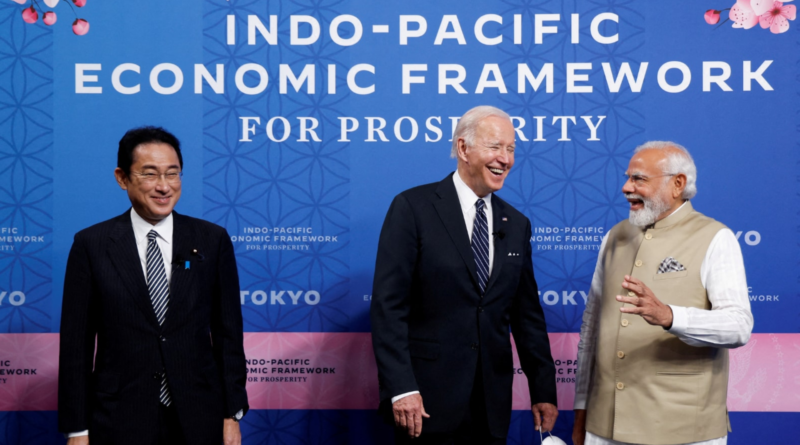INDO-PACIFIC ECONOMIC FRAMEWORK (IPEF)
On May 23, 2022, the Indo-Pacific Economic Framework for Prosperity (IPEF) was launched in Tokyo. IPEF is a new economic initiative led by the United States for the Indo-Pacific region. Prime Minister Narendra Modi joined US President Joe Biden and Japanese Prime Minister Fumio Kishida for the launch. The representatives of 10 other partner countries were present virtually. The thirteen initial partner countries of IPEF are India, Japan, the United States, Australia, Brunei, Indonesia, the Republic of Korea, Malaysia, New Zealand, the Philippines, Singapore, Thailand, and Vietnam. Hence, this diverse set of economies forms about 40% of the global GDP. And as IPEF moves forward through the years, more countries are welcome to join the framework.
WHAT DOES INDIA HAVE TO SAY?
“Trust, transparency, and timeliness are key for a successful Indo-Pacific Economic Framework.”, said PM Modi. India aims for an open, free, and inclusive Indo-Pacific region. Moreover, India believes that deepening economic engagement is crucial for continued growth, peace, and prosperity among partners. So on 23 May 2022, India signed an Investment Incentive Agreement (IIA) with the United States. This agreement is signed to make way to strengthen and promote Development Finance Corporation’s investments in India in various important sectors.
MOTIVES OF IPEF
IPEF will bring to life US President Biden’s commitment to putting American families and workers at the center of their economic and foreign policy. This framework will strengthen the United States’ ties with its allies and partners. This will increase shared prosperity and technological innovation in the coming decades in the Indo-Pacific region.
The four main pillars on which IPEF stands are clean energy and decarbonization, trade, supply chain resilience, and taxes and anti-corruption measures. Member countries would have to sign up for all components of the module. They do not necessarily have to take part in all modules. IPEF is not a “free trade agreement” nor will include market access commitments such as reducing tariff barriers.
IPEF is the US President’s attempt to regain credibility in the region. This is after former President Donald Trump withdrew from the Trans-Pacific Partnership in 2017. And it is also not a replacement for RCEP, the Regional Comprehensive Economic Partnership. India withdrew from RCEP and China is still a member. The US administration is trying to re-engage with the Indo-Pacific region. Therefore, IPEF will dissolve all concerns over the absence of a credible US economic and trade strategy in the region.
CONCLUSION
IPEF is an administrative arrangement committed to tackling 21st-century economic issues. Hence, it will become an engine of global economic growth if moved in the right direction. The focus of partner countries will be on economic cooperation. So this will create a stronger and more resilient economy. Not only for families, and businesses but also for workers in the whole of the Indo-Pacific region. Hence, the Indo-Pacific region will be the largest contributor to the GDP. With almost 60% of the world’s population in the next 30 years.
Do read: COAL CRISIS- A LOOMING STRUGGLE




